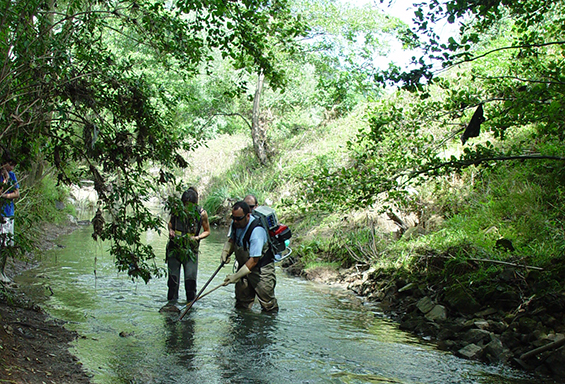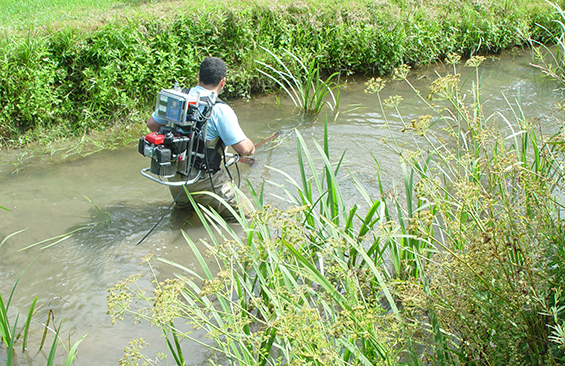
At one time or another you have probably seen anglers in the basins of some of our rivers.Most likely you know or assume that there are rules regarding where, how and how much you can fish.But, on the basis of what criteria are those rules established?
The team of Dr Álvaro Antón Baranda, a professor at the Department of Teaching of Mathematics and Experimental Sciences at the University of the Basque Country (UPV/EHU), has worked for various regional governments and county councils, particularly in Bizkaia, collecting enough population data to allow them to establish suitable fishing quotas for species that are used in recreational fishing.“Trout is the species that perhaps attracts the most attention”, remarked Álvaro, “but there are other species such as barbel and parachondrostoma arrigonis, which deserve our attention from a conservation perspective.”
How do you estimate the fish populations in a river?Samples are taken in stretches that are chosen because of their representativeness.All of the fish present in those stretches are counted using the electrofishing technique.To do this, a generator with an alternating current is used, which is then converted into a regulated direct current.One of the poles is inserted into the water.The sampler, protected with suitable equipment, carries the other pole.When the circuit is closed, if the current intensity has been accurately calculated, the fish that are inside the electric field make twitching movements that bring them closer to the sampler and, finally, they experience galvanonarcosis (unconsciousness).This allows the researcher to remove and count them and to study the fish that are present and, if all of the stretches that were selected are suitable, to extrapolate the total population of the river in that area.The animals are then returned to the river without being harmed.
“We make an inventory of all of the species, not just the ones for which a quota has to be established.We are interested in the health of the river and the conservation of our ecosystems," explains Álvaro.“Our fish are facing numerous problems:rivers with a high degree of disturbance, with reduced flows and point and nonpoint pollution, the introduction of invasive ichthyophagous species (which feed on other fish) for which the local fauna is ill-suited and other problems caused by bad practices by some river users.”
Also, because trout are so popular for recreational fishing, central European trout from fish hatcheries have been being introduced into our rivers for decades.People thought it was the same animal.We now know that our native trout are unique and that this process was harming populations due to competition, genetic simplification and hybridisation.

“Despite all of these problems, there are still some grounds for optimism”, remarked Álvaro, as he described the experience in the Berrón stretch of the River Cadagua, where it passes through Balmaseda. This is a natural area with plenty of trout and it is very attractive for anglers. In collaboration with the Department of Sustainability and the Environment of Bizkaia Regional Council, fishing was banned and they stopped introducing trout, which until then had been done to artificially maintain the large numbers being fished in the area.Then, the dynamics of the population were studied in a highly controlled system.When they were able to establish the upper limit of the population and its tolerances, in 2003 they tried allowing small scale fishing:aa maximum of two anglers and two trout each per day.Yearly studies have found that the population remains stable and there is no need to introduce more trout from outside. All of this has also largely been made possible by the goodwill shown by the anglers, that vast majority of whom have understood the need to protect these unique places. Due to the large amount of interest in fishing in this section, the anglers agree that the few places available each year should be awarded by lot.
In addition to Álvaro, this team of researchers is composed of DrAna Rallo, Professor of Zoology at UPV/EHU and the leader of the group; DrLoreto García Arberas, a professor at the Begoñako Andra Mari Teacher Training School; and Nuria Olarte, a PhD researcher whose dissertation is on the native crayfish.All of their work focuses on freshwater environments (rivers, lakes, ponds etc.) and they currently have ongoing projects to study both the population dynamics of species fished by anglers and species with conservation problems such as the stickleback (classified as vulnerable) and the native crayfish (endangered species).Their objective is to generate knowledge that helps the authorities in their decision-making.They have been carrying out this type of research for 15 years and combining it with other contracts with companies (environmental impact consultancy, construction work etc.).
As far as Álvaro is concerned, the fact that they perform this work at the university is a way of giving something back, a kind of public service.“We are facing major environmental challenges, meaning significant management issues. At the university we can help to resolve these problems.We are valued because we look at problems from a global perspective, independently and, at any rate, with a focus on the conservation of our natural resources. We try to offer solutions.”
Do you need an expert? Contact us
What is the benefit of contracting projects with companies?
¿Cómo puedo contratar proyectos con la Universidad?
Euskoiker has more than 30 years of experience managing all kinds of projects